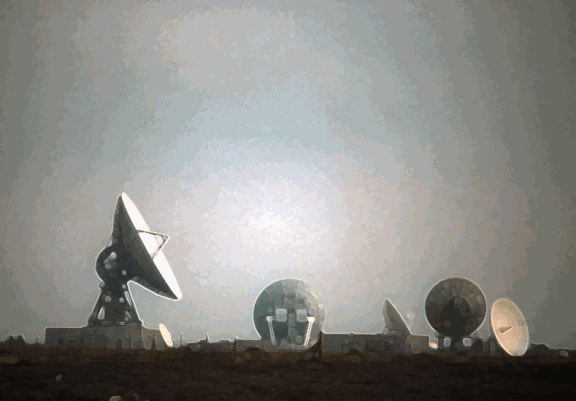By combining the results from several powerful techniques for studying materials structure at the nanoscale, including work at the U.S. Department of Energy’s Advanced Photon Source (APS) at Argonne National Laboratory, an international team of reseaerchers believe they have settled a long-standing debate over the source of the unique electronic properties of silver niobate, a material with potentially great importance for wireless communications.
The new study of silver niobate not only opens the door to engineering improved electronic components for smaller, higher-performance wireless devices, but also serves as an example of understanding how the subtle nanoscale features of a material can give rise to major changes in its physical properties.
Silver niobate is a ceramic dielectric, a class of materials used to make capacitors, filters, and other basic components of wireless communications equipment and other high-frequency electronic devices. A useful dielectric needs to have a large dielectric constant—roughly, a measure of the material’s ability to hold an electric charge—that is stable in the operating temperature range. The material should also feature low dielectric losses, which means that it does not waste energy as heat, and preserves much of its intended signal strength. In the important gigahertz range of the radio spectrum—used for a wide variety of wireless applications—silver niobate-based ceramics are the only known materials that combine a high, temperature-stable dielectric constant with sufficiently low dielectric losses.
It has been known for some time that silver niobate’s unique dielectric properties are temperature dependent; the peak of the dielectric constant occurs in a broad range near room temperature in these ceramics, which makes them suitable for practical applications. Earlier studies were unable to identify the structural basis of the unusual dielectric response because no accompanying changes in the overall crystal structure could be observed. “The crystal symmetry doesn’t seem to change at those temperatures,” said National Institute of Standards and Technology (NIST) materials scientist Igor Levin, “but that’s because people were using standard techniques that tell you the average structure. The important changes happen at the nanoscale and are lost in averages.”
Only in recent years, said Levin, have the specialized instruments and analytic techniques been available to probe nanoscale structural changes in crystals. Even so, he said, “these subtle deviations from the average are so small that any single measurement gives only partial information on the structure. You need to combine several complementary techniques that look at different angles of the problem.”
The researchers are from NIST, Argonne, Brookhaven National Laboratory, Los Alamos National Laboratory, Rutherford Appleton Laboratory, and The University of Sheffield.
Working at the XOR/UNI 33-BM-C beamline at the APS, the NIST X23A2 beamline at the National Synchrotron Light Source, the Lujan Neutron Scattering Center, and the ISIS Pulsed Neutron & Muon Source, the group combined results from several high-resolution probes using x-rays, neutrons, and electrons—tools that are sensitive to both the local and average crystal structure—to understand silver niobate’s dielectric properties. The results revealed an intricate interplay between the oxygen atoms, arranged in an octahedral pattern that defines the compound’s crystal structure, and the niobium atoms at the centers of the octahedra.
At high temperatures, the niobium atoms are slightly displaced, but their average position remains in the center, so the shift is not seen in averaging measurements. As the compound cools, the oxygen atoms cooperate by moving a little, causing the octahedral structure to rotate slightly. This movement generates strain which “locks” the niobium atoms into off-centered positions—but not completely. The resulting partial disorder of the niobium atoms gives rise to the dielectric properties. The results, the researchers say, point to potential avenues for engineering similar properties in other compounds.
Contact: I Levin, [email protected]
See: I. Levin, V. Krayzman, J.C. Woicik, J. Karapetrova, T. Proffen, M.G. Tucker, and I.M. Reaney, “Structural changes underlying the diffuse dielectric response in AgNbO3,” Phys. Rev. B 79, 104113 (2009). DOI: 10.1103/PhysRevB.79.104113
The original NIST press release .
The work was made possible by national user facilities: the Lujan Center at Los Alamos Neutron Science Center funded by the U.S. Department of Energy, Office of Science, Office of Basic Energy Sciences (DOE-BES), and Los Alamos National Laboratory under Contract No. W-7405-ENG-36; and the Advanced Photon Source supported by the DOE-BES under Contract No. W-31-109-ENG-38. Experiments at the ISIS Pulsed Neutron & Muon Source were supported by a beam-time allocation from the Science and Technology Facilities Council.
Argonne National Laboratory seeks solutions to pressing national problems in science and technology. The nation's first national laboratory, Argonne conducts leading-edge basic and applied scientific research in virtually every scientific discipline. Argonne researchers work closely with researchers from hundreds of companies, universities, and federal, state and municipal agencies to help them solve their specific problems, advance America 's scientific leadership and prepare the nation for a better future. With employees from more than 60 nations, Argonne is managed by UChicago Argonne, LLC for the U.S. Department of Energy's Office of Science.

